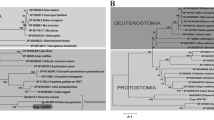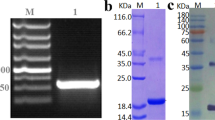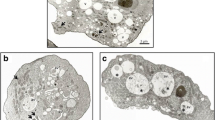Abstract
Proteasomal proteolysis is required for a wide range of cellular processes, including protein quality control, cell cycle progression, cell death and metabolic adaptation to environment changes or stress responses. Proteasome inhibitors are useful compounds for determining the roles of proteasome in eukaryotic cells. Here, we investigated the effects of gliotoxin, a proteasome inhibitor, on the cell growth, replication, ultrastructure, DNA integrity and proteasomal proteolytic activity of the protist parasite Tritrichomonas foetus. The effect of gliotoxin on the transformation of T. foetus to endoflagellar form (EFF), also known as pseudocyst, was investigated. Gliotoxin inhibited the culture growth, arrested cell cycle, and provoked a trichomonacidal effect in a dose-dependent manner. Parasites treated with gliotoxin displayed features typical of cell death, such as membrane blebbing, concentric membrane whorls containing remnants of organelles, intense cytosolic and nuclear vacuolisation, chromatin condensation, DNA fragmentation, cytoplasmic disintegration and plasma membrane disruption. The proteasomal peptidase activity was inhibited by gliotoxin in a dose-dependent manner. Gliotoxin treatment also induced an irreversible EFF transformation in a dose/time-dependent manner. We compared morphological characteristics between gliotoxin- and cold-induced EFF parasites. Our results suggest that gliotoxin could induce EFF transformation by a mechanism distinct from that provoked by cold temperature. This study further contributes to a better understanding of the role of proteasome system in cell cycle, cell death and EFF transformation in T. foetus.









Similar content being viewed by others
References
Abramova EB, Astakhova TM, Erokhov PA, Sharova NP (2004) Multiple forms of the proteasomes and some approaches to their separation. Biol Bull 31:115–120
Belkacemi L, Barton RC, Hopwood V, Evans EG (1999) Determination of optimum growth conditions for gliotoxin production by Aspergillus fumigatus and development of a novel method for gliotoxin detection. Med Mycol 37:227–233
Cardoso J, Soares MJ, Menna-Barreto RF, Le Bloas R, Sotomaior V, Goldenberg S, Krieger MA (2008) Inhibition of proteasome activity blocks Trypanosoma cruzi growth and metacyclogenesis. Parasitol Res 103:941–951. doi:10.1007/s00436-008-1081-6
Chung DW, Ponts N, Prudhomme J, Rodrigues EM, Le Roch KG (2012) Characterization of the ubiquitylating components of the human malaria parasite’s protein degradation pathway. PLoS One 7:e43477. doi:10.1371/journal.pone.0043477
de Andrade RI, de Souza W, Benchimol M (2013) High-resolution scanning electron microscopy of the cytoskeleton of Tritrichomonas foetus. J Struct Biol 183:412–418. doi:10.1016/j.jsb.2013.07.002
Diamond LS (1957) The establishment of various trichomonads of animals and man in axenic cultures. J Parasitol 43:488–490
Dolan SK, O’Keeffe G, Jones GW, Doyle S (2015) Resistance is not futile: gliotoxin biosynthesis, functionality and utility. Trends Microbiol 23:419–428. doi:10.1016/j.tim.2015.02.005
Fabre B, Lambour T, Delobel J, Amalric F, Monsarrat B, Burlet-Schiltz O, Bousquet-Dubouch MP (2013) Subcellular distribution and dynamics of active proteasome complexes unraveled by a workflow combining in vivo complex cross-linking and quantitative proteomics. Mol Cell Proteomics 12:687–699. doi:10.1074/mcp.M112.023317
Fang YK, Huang KY, Huang PJ, Lin R, Chao M, Tang P (2015) Gene-expression analysis of cold-stress response in the sexually transmitted protist Trichomonas vaginalis. J Microbiol Immunol Infect 48:662–675. doi:10.1016/j.jmii.2014.07.013
Garoussi MT, Khosrave AR, Havareshti P (2007) Mycoflora of cervicovaginal fluids in dairy cows with or without reproductive disorders. Mycopathologia 164:97–100. doi:10.1007/s11046-007-9031-x
Groll M, Huber R (2004) Inhibitors of the eukaryotic 20S proteasome core particle: a structural approach. Biochim Biophys Acta 1695:33–44. doi:10.1016/j.bbamcr.2004.09.025
Hatabu T, Hagiwara M, Taguchi N, Kiyozawa M, Suzuki M, Kano S, Sato K (2006) Plasmodium falciparum: the fungal metabolite gliotoxin inhibits proteasome proteolytic activity and exerts a plasmodicidal effect on P. falciparum. Exp Parasitol 112:179–183. doi:10.1016/j.exppara.2005.11.012
Hubmann R, Hilgarth M, Schnabl S, Ponath E, Reiter M, Demirtas D, Sieghart W, Valent P, Zielinski C, Jäger U, Shehata M (2013) Gliotoxin is a potent NOTCH2 transactivation inhibitor and efficiently induces apoptosis in chronic lymphocytic leukaemia (CLL) cells. Br J Haematol 160:618–629. doi:10.1111/bjh.12183
Kreidenweiss A, Kremsner PG, Mordmüller B (2008) Comprehensive study of proteasome inhibitors against Plasmodium falciparum laboratory strains and field isolates from Gabon. Malar J 7:187. doi:10.1186/1475-2875-7-187
Kroll M, Arenzana-Seisdedos F, Bachelerie F, Thomas D, Friguet B, Conconi M (1999) The secondary fungal metabolite gliotoxin targets proteolytic activities of the proteasome. Chem Biol 6:689–698. doi:10.1016/S1074-5521(00)80016-2
Kweon YO, Paik YH, Schnabl B, Qian T, Lemasters JJ, Brenner DA (2003) Gliotoxin-mediated apoptosis of activated human hepatic stellate cells. J Hepatol 39:38–46. doi:10.1016/S0168-8278(03)00178-8
Makioka A, Kumagai M, Ohtomo H, Kobayashi S, Takeuchi T (2002) Effect of proteasome inhibitors on the growth, encystation, and excystation of Entamoeba histolytica and Entamoeba invadens. Parasitol Res 88:454–459. doi:10.1007/s00436-002-0601-z
Malik SB, Pightling AW, Stefaniak LM, Schurko AM, Logsdon JM Jr (2007) An expanded inventory of conserved meiotic genes provides evidence for sex in Trichomonas vaginalis. PLoS One 3:e2879. doi:10.1371/journal.pone.0002879
Mariante RM, Vancini RG, Benchimol M (2006) Cell death in trichomonads: new insights. Histochem Cell Biol 125:545–556. doi:10.1007/s00418-005-0098-5
Muñoz C, San Francisco J, Gutiérrez B, González J (2015) Role of the ubiquitin-proteasome systems in the biology and virulence of protozoan parasites. Biomed Res Int 2015:141526. doi:10.1155/2015/141526
Pahl HL, Krauss B, Schulze-Osthoff K, Decker T, Traenckner EB, Vogt M, Myers C, Parks T, Warring P, Mühlbacher A, Czernilofsky AP, Baeuerle PA (1996) The immunosuppressive fungal metabolite gliotoxin specifically inhibits transcription factor NF-kappaB. J Exp Med 183:1829–1840
Paniagua Soriano G, De Bruin G, Overkleeft HS, Florea BI (2014) Toward understanding induction of oxidative stress and apoptosis by proteasome inhibitors. Antioxid Redox Signal 21:2419–2443. doi:10.1089/ars.2013.5794
Paugam A, Creuzet C, Dupouy-Camet J, Roisin P (2002) In vitro effects of gliotoxin, a natural proteasome inhibitor, on the infectivity and proteolytic activity of Toxoplasma gondii. Parasitol Res 88:785–787. doi:10.1007/s00436-002-0644-1
Pereira-Neves A, Benchimol M (2009) Tritrichomonas foetus: budding from multinucleated pseudocysts. Protist 160:536–551. doi:10.1016/j.protis.2009.05.001
Pereira-Neves A, Campero CM, Martínez A, Benchimol M (2011) Identification of Tritrichomonas foetus pseudocysts in fresh preputial secretion samples from bulls. Vet Parasitol 175:1–8. doi:10.1016/j.vetpar.2010.10.007
Pereira-Neves A, Rosales-Encina JL, Meyer-Fernandes JR, Benchimol M (2014) Tritrichomonas foetus: characterisation of ecto-phosphatase activities in the endoflagelar form and their possible participation on the parasite’s transformation and cytotoxicity. Exp Parasitol 142:67–82. doi:10.1016/j.exppara.2014.04.007
Pereira-Neves A, Gonzaga L, Menna-Barreto RF, Benchimol M (2015) Characterisation of 20S proteasome in Tritrichomonas foetus and its role during the cell cycle and transformation into endoflagellar form. PLoS One 10:e0129165. doi:10.1371/journal.pone.0129165
Rivett AJ, Gardner RC (2000) Proteasome inhibitors: from in vitro uses to clinical trials. J Pept Sci 6:478–488
Selman C, Grune T, Stolzing A, Jakstadt M, McLaren JS, Speakman JR (2002) The consequences of acute cold exposure on protein oxidation and proteasome activity in short-tailed field voles, Microtus agrestis. Free Radic Biol Med 33:259–265. doi:10.1016/S0891-5849(02)00874-2
Shaw MK, He CY, Roos DS, Tilney LG (2000) Proteasome inhibitors block intracellular growth and replication of Toxoplasma gondii. Parasitology 121:35–47
Silva-Jardim I, Horta MF, Ramalho-Pinto FJ (2004) The Leishmania chagasi proteasome: role in promastigotes growth and amastigotes survival within murine macrophages. Acta Trop 91:121–130. doi:10.1016/j.actatropica.2004.03.007
Speth C, Kupfahl C, Pfaller K, Hagleitner M, Deutinger M, Würzner R, Mohsenipour I, Lass-Flörl C, Rambach G (2011) Gliotoxin as putative virulence factor and immunotherapeutic target in a cell culture model of cerebral aspergillosis. Mol Immunol 48:2122–2129. doi:10.1016/j.molimm.2011.07.005
Tan X, Osmulski PA, Gaczynska M (2006) Allosteric regulators of the proteasome: potential drugs and a novel approach for drug design. Curr Med Chem 13:155–165. doi:10.2174/092986706775197926
Tanaka K, Mizushima T, Saeki Y (2012) The proteasome: molecular machinery and pathophysiological roles. Biol Chem 393:217–234. doi:10.1515/hsz-2011-0285
Wojcik S (2013) Crosstalk between autophagy and proteasome protein degradation systems: possible implications for cancer therapy. Folia Histochem Cytobiol 51:249–264. doi:10.5603/FHC.2013.0036
Yao C, Köster LS (2015) Tritrichomonas foetus infection, a cause of chronic diarrhea in the domestic cat. Vet Res 46:35. doi:10.1186/s13567-015-0169-0
Yeh YM, Huang KY, Richie Gan RC, Huang HD, Wang TC, Tang P (2013) Phosphoproteome profiling of the sexually transmitted pathogen Trichomonas vaginalis. J Microbiol Immunol Infect 46:366–73. doi:10.1016/j.jmii.2012.07.010
Acknowledgments
This work was supported by Conselho Nacional de Desenvolvimento Científico e Tecnológico (CNPq), Fundação Carlos Chagas Filho de Amparo à Pesquisa do Estado do Rio de Janeiro (FAPERJ), Programa de Núcleos de Excelência (PRONEX) and Coordenação de Aperfeiçoamento de Pessoal de Nível Superior (CAPES).
Author information
Authors and Affiliations
Corresponding author
Electronic supplementary material
Below is the link to the electronic supplementary material.
Online Resource 1
Comparison between parasites undergoing the process of gliotoxin- and cold-induced EFF transformation by SEM. The recurrent flagellum is not externally visible. Some anterior flagella (F) are still externally visible. (a-b) Parasites were incubated with 1 μM gliotoxin for 9 h at 37 °C. EFF parasites exhibit wrinkled surface, membrane (arrows) and flagellar (asterisk) blebbing. (c-d) Parasites were incubated for 2 h at 4 °C. EFF parasites do not exhibit membrane and flagellar blebbing. Bars, a-b, c, 2 μm; d, 1 μm. (GIF 275 kb)
Rights and permissions
About this article
Cite this article
Pereira-Neves, A., Menna-Barreto, R.F.S. & Benchimol, M. The fungal metabolite gliotoxin inhibits proteasome proteolytic activity and induces an irreversible pseudocystic transformation and cell death in Tritrichomonas foetus . Parasitol Res 115, 3057–3069 (2016). https://doi.org/10.1007/s00436-016-5061-y
Received:
Accepted:
Published:
Issue Date:
DOI: https://doi.org/10.1007/s00436-016-5061-y




